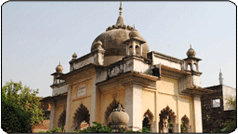
Stamp Released by Indian Government on Mir Anees
Dr.Mazhar
Naqvi
Marsiya
and Mir Anees are inseparable and unforgettable. But people have surely erased
the memory of the Imambara erected by ‘Khuda-E-Sukhan’
(creator of words) in Lucknow from their minds. During Muharram, his marsiyas
are recited in ‘Majalis-E-Aza’ all
over the world. But ironically not a single word is ever uttered about the grief
and pain suffered by Mir Anees after demolition of his Imambara by the British.
Sketchy details available about Imambara give two versions about its erection.
One
legend says that once the great poet was invited by Dayant- Ud -Daula to recite
marsiya in a majlis. The host became so delighted by the excellent performance of
Anees that he offered the ownership of his own Imambara to the poet. He also
offered him a house near the Imambara. DAneesh, a descendant of Mir Anees confirms
in his account that the Imambara was demolished after recapture of Lucknow in
1857. He has reproduced a poem of 15 couplets by Mufti Mir Abbas. His last
couplet offers chronogram of the Imambara and lamentation on its demolition. Imambara
was located in front of what is today known as Haathi Park. Imambara must have
been quite an impressive one if one gets any indication from the temperament of
Dayant- Ud- Daula who was a great builder as is evident from the magnificence of
Karbala built by him in 1852.He was a Khwajasara(eunuch) named Muhammad Hussain
Ali. He was very close to the heir apparent Wajid Ali Shah .After ascending
throne, Wajid Ali Shah had appointed him as the in- charge of his ‘Parikana’. The
king also changed his name to Muhammad Mutamud Ali Khan and bestowed upon him
the title of Dayanat-Ud- Daula.
An
article published in the city edition of a popular English daily of Lucknow however
contradicts any association of Dayanat-Ud-Daula with Imambara Mir Anees. The
write-up says that Anees had shifted along with
his father Mir Khaliq to Lucknow in 1842. The family initially settled down at
Shaidon ka Hata( Compound). Anees built an Imambara over the grave of his
father near his residence after his death in 1844. The article also confirms
the demolition of Imambara by the British in 1857. It is a well known fact that
the British had blown off two third of the total Nawabi buildings after
recapture of Lucknow. So intense and barbaric was the persecution of the British
that Mir Anees along with his family members shifted to Malihabad to save
himself from the wrath of invaders. Faqir Mohammad Khan ‘Goya’, the
grand-father of revolutionary poet Josh Malihabadi accommodated Anees and his
family in the orchards by putting camps there. Goya extended
true hospitality to the ‘marsiyago’(reciter
of elegiac poetry). When normalcy restored in Lucknow, Mir Anees returned
to Lucknow. He stayed in Mansur Nagar in the house of his student Mirza Ahmed
Abbas for some time. He also lived in the Raja Ka Bazaar area in Munshi
Sirajuddin's house as a tenant. In 1862, Anees purchased a house in ‘Chaubdari Mohalla’
in Chowk area of old Lucknow. He lived there till his death 1874. To
what extent the demolition of Imambara gave him grief is evident from the
marsiyas written by him after 1857. One can feel
the agony of the tragic events that followed the Begum Hazrat Mahal led campaign
against the British rule in his later compositions. It will be a befitting
tribute to Mir Anees if zakirs and marsiyakhwans
make a reference of his plight and sufferings after the demolition of his Imambara
whenever they get a chance. Such a move will surely let his admirers know this
hidden aspect of his life. (Reference
available on request)

Last resting Place of Mir Anis in Lucknow.
No comments:
Post a Comment